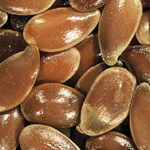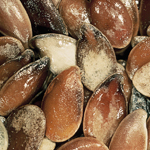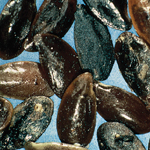Harvesting Flax
Flax may be harvested by straight combining or by cutting with a swather and threshing later with a combine. Straight combining is the preferred method if the crop is thoroughly dry and free of weeds. Swathing followed by combining has become popular because this method assures drier seed than with straight combining, particularly if the crop is not uniformly mature or if weeds are present.
Flax is considered to be fully mature when 75% of the bolls have turned brown. After this stage has been reached, the crop may be swathed. If regrowth occurs in the fall, cut the crop when the greatest amount of ripe seed can be obtained. Do not delay the harvest too long because fall rains may cause weathering of the mature seed and frost may cause immature seed to turn black, resulting in a reduction in grade.
Considerable frost damage occurs in immature seeds when temperatures drop to the -3° to -5°C range (27° to 23°F), while leaves are severely damaged at -4° to -5°C (25° to 23°F) and stems at -6° to -7°C (21° to 19°F). Cutting or desiccating flax at an immature stage is not known to result in seed blackening, but yields will be reduced due to early termination of seed development. This will result in thin seeds of lower weight.
Swathing
When swathing, leave a stubble of about 10 to 15 cm (4 to 6 in.) to hold the swath off the ground and facilitate drying. To prevent blowing of the swath by strong winds, flax swaths should be rolled. Swathed flax may be ready to combine after exposure to a few days of dry weather. The swath may be threshed when the leaves and stems are dry enough and the seeds rattle in the boll, or the seed has dried to the desired moisture level as indicated by a moisture meter. Although seed is considered dry enough for storage at 10% moisture (Canadian Grain Commission, Official Grain Grading Guide, effective August 1990), the crop may be harvested at a higher seed moisture if drying facilities are available. Usually, early-sown flax is easier to thresh than late-sown flax because it has a better chance to mature under drier conditions.Keep the cutter bars of combines or swathers clean and sharp to ensure a smooth cut and to prevent accumulation of immature flax under the knife. Gumming of the cutting parts can be reduced by frequent application of water or kerosene.
Chemical Desiccation
Chemical desiccation may be used to accelerate drying of the crop and any weeds that may be present. It does not speed crop maturity, but will reduce the time from maturity to harvest. Potential advantages from this practice are:
• earlier harvesting; elimination of the need for swathing; reduction in combining time; less wear and tear on machinery; cleaner seed;
• reduction or elimination of the need for artificial drying.
A desiccant may be applied after 75% of the bolls have turned brown, which is the normal time of swathing. Studies at Morden, Manitoba have shown that yields are reduced if applications are made too early. For instance, swathing or desiccating at the 25 to 50% brown boll stages, reduced yields by an average of about 10% and 5% respectively, due to premature termination of development of some of the seed.Desiccated flax should be harvested as soon as possible after it is ready, to avoid capsule loss and weathering of the seed. For up-to-date information refer to the latest provincial recommendations, or consult your local agricultural representative.
Threshing
It is important that combine adjustments are correct for threshing flax. The seedcoat of flax is easily broken during threshing, particularly if the cylinder speed is too high and the seed is very dry. Damaged seed has reduced germination. If the seed is to be used for planting, great care in threshing is required. Yellow-seeded varieties are more susceptible to seed damage because of their thinner seedcoat.
It may be necessary to adjust the combine from time to time during the day depending on temperature, relative humidity and the condition of the flax. The manual provided with the combine should be consulted for correct settings.
Storage of Seed
 The percentage of flax grading Canada #1 is frequently very high, but dockage is often up to 10%. Dockage can be reduced by controlling broadleaf weeds as well as grassy weeds — including volunteer cereals. If green weed seeds are present, they may raise the moisture of the flax seeds enough to cause heating and moulding. Removing this dockage before putting the flax into long-term storage is advisable.
The percentage of flax grading Canada #1 is frequently very high, but dockage is often up to 10%. Dockage can be reduced by controlling broadleaf weeds as well as grassy weeds — including volunteer cereals. If green weed seeds are present, they may raise the moisture of the flax seeds enough to cause heating and moulding. Removing this dockage before putting the flax into long-term storage is advisable.
 Sample of No.2 Canada flax seed. This seed shows the rime or scabbing which occurs in years with a wet harvest. This condition is not considered damage as long as the seed is otherwise sound.
Sample of No.2 Canada flax seed. This seed shows the rime or scabbing which occurs in years with a wet harvest. This condition is not considered damage as long as the seed is otherwise sound.
Heated Flax
 Stored flax requires more attention than does stored wheat. Freshly harvested seed can maintain a high respiration rate for up to six weeks before becoming dormant. This, coupled with mould growth if the relative humidity of the air in the spaces between the seeds rises above 70%, can lead to heating. Once flax starts heating in a pocket, the heat will spread quickly - possibly throughout the entire bin. For this reason, flax seed should be cooled down after it is put into storage.
Stored flax requires more attention than does stored wheat. Freshly harvested seed can maintain a high respiration rate for up to six weeks before becoming dormant. This, coupled with mould growth if the relative humidity of the air in the spaces between the seeds rises above 70%, can lead to heating. Once flax starts heating in a pocket, the heat will spread quickly - possibly throughout the entire bin. For this reason, flax seed should be cooled down after it is put into storage.
Flax seed can be safely stored at seed moisture levels of 10% or lower. Tough flax contains from 10.1 to 13.5% moisture; damp flax is over 13.5% moisture (Canadian Grain Commission, Official Grain Grading Guide, effective August 1990). Each year some heated flax seed shows up in the delivery system. A wet harvest or an early fall frost will increase the percentage of heated flax. If aeration equipment is not available, bins of flax seed should be inspected frequently for problem spots until the seed has cooled down. Flax seed has an airflow resistance very similar to Polish-type canola (B. campestris). Periodic checking is necessary to detect the development of hot spots.As in other oilseeds and cereal grains, moisture migration will occur in stored flax seed. Even though the seed is binned with uniform moisture, high moisture spots can develop by moisture migration. This usually happens in fall and early winter, although it can also occur in the spring.
Storage Insects
Stored flax seed is not troubled by storage insects as frequently as cereal grains. Insects that can occur in stored flax are: saw-toothed grain beetle, confused flour beetle, merchant grain beetle and red flour beetle. Various fungus beetles and numerous mites can be found in seed that remains tough to damp in storage. Research in Manitoba has revealed that flax varieties vary in their susceptibility to the saw-toothed grain beetle. The rusty grain beetle occurs occasionally in carlots of flax. However, it is suspected that this insect feeds on cereal admixtures in the flax.The optimum temperature for rapid growth of insects is in the range of 30° to 35°C (86° to 95°F). Their activity is greatly retarded by temperature below 18°C (64°F). If the grain is cool and dry, insects will generally not thrive. However, flax may be put into storage at an acceptable moisture content and temperature, but pockets of high moisture and temperature can develop later through moisture movement on convection currents and heat production by mould respiration which would encourage insect activity.

